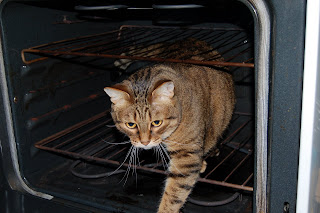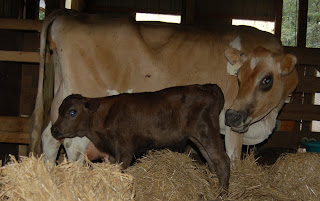
Hickory at age 10, the last living member of the barn cat trio of Hickory, Dickory, and Doc
Born: Spring 1997
Adopted: Summer 1997
Died: Monday, April 9, 2007
When one spends a great deal of time with a community of animals, certain things become apparent. Personalties, hierarchies, likes and dislikes, and occasionally the odd alliance between unlikely companions. Hickory clearly liked her littermate Dickory best, and she never bonded closely with any of the other cats. Yet the kitten she terrorized most turned out to be the closest thing to a kitty friend she had, so long as he acknowledged her superiority and followed her rules. He alone was allowed to cuddle in the old ratty chair in the barn with her, though only on the coldest of nights. Humans, however, were best utilized as Hickory petting slaves. Idle hands weren't to be tolerated, and those who ignored her hints might get a stronger hint -- a quick poke with the claw tips. She wasn't vicious. She was just reminding you she was there...waiting...getting impatient.
Several years ago she developed a dark spot in one eye. The spot gradually spread until she had one good golden eye and one brown eye. In the last year, her eyesight became worse in the dark eye. She could still sense movement, but not what caused that movement, so waving a hand on that side often earned a nasty hiss and a smacking. Despite her disability, she maintained her position as Queen of the Barn. No cat dared venture within her defined perimeter without permission. Those allowed within that circle had to follow her rules.
1. No stealing cuddles from the humans -- hiss, smack.
2. In fact, do not think of even making eye contact with the humans -- growl, hiss.
3. No milk until Hickory finishes her share as defined by her, and then no milk unless Rules One and Two have been properly observed, several additional minutes have passed, and express permission has been granted by Hickory. Growl. Hiss. Smack, smack, smack, smack.
4. First dibs on fat mice go to Hickory. Leftovers distributed via Rule Three terms.
We'll miss ya, Hickory Pud.
 On the right, aspirin for people. On the left, aspirin for cows. Twice a day, Lottie, the Jersey cow, gets two of the big ones. The instructions say 'by bolus' which is a fancy way of saying 'poke it down her throat.' It's a common technique, and every feed supply store sells a simple tool to help with that. I know how it's done. I've seen it done. It's just not happening here, now, with this cow when I don't have a squeeze chute to immobilize her. I have enough trouble poking pills down cats' throats.
On the right, aspirin for people. On the left, aspirin for cows. Twice a day, Lottie, the Jersey cow, gets two of the big ones. The instructions say 'by bolus' which is a fancy way of saying 'poke it down her throat.' It's a common technique, and every feed supply store sells a simple tool to help with that. I know how it's done. I've seen it done. It's just not happening here, now, with this cow when I don't have a squeeze chute to immobilize her. I have enough trouble poking pills down cats' throats. Fortunately, the vet said I could grind up the aspirin boluses and mix them with grain. Add a little warmed molasses, thinned 50/50 with water to bind the powder to the grain, and Lottie has a therapeutic morning snack.
Fortunately, the vet said I could grind up the aspirin boluses and mix them with grain. Add a little warmed molasses, thinned 50/50 with water to bind the powder to the grain, and Lottie has a therapeutic morning snack. 



































